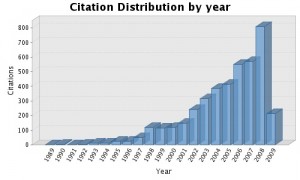Hire at a normalised 1 only
Tags: citations, h-index, hiring, professors, publications, ResearcherId,web of sciencePosted in High-impact journals, Tips
The other day I met a professor from a pretty good department and he said something along the lines of “of course the h-index is not important but it is funny that all the hires we have made over the years had a normalised h-index of 1 or above and when they didn’t, questions were asked”. So the conclusion really is that to be hired you need a normalised h-index greater or equal than 1.
What’s this all about? First the h-index, in case you have been in the bush and haven’t heard about it yet. There’s good explanation on the wiki page on the h-index. Briefly, if you order your publications by the number of citations in decreasing order and index them 1,2,3, etc., when the index becomes equal to the number of citations, you have found your h-index. Thus, an h-index of 10 means that you have 10 papers with 10 citations or more. It filters for outliers such as one paper with a 1000 citations. The normalised h-index (hbar?) is the h-index divided by the number of years that have passed since your first publication. Supposedly (I can’t find where I read this now), an h-index of 20 when you have been in your career for 20 years qualifies you to become a full professor.
Anyway, the professor I mentioned above probably referred to hires at a junior level (assistant professor, lecturer, whatever it is called where you are). It might be reasonable to assume that junior hires have been in a postdoc for about 5 years, so his department would expect and h-index of 5 after 5 years. Does this sound reasonable to you? I personally think that having a look at somebody’s h-index is good as long as you dig a bit deeper to find out why it is low or high and look at other things too.
Speaking of h-indices. Web of Science now connects to something called ResearcherId where you can set up web pages for yourself displaying your h-index and graphs showing the number of citations per year. A colleague of mine (different from the one above) with a normalised h-index of about 1.7 has such a page and I thought you might be suitably bowled over by his citation graph. Suffice to say that my graph doesn’t look quite as impressive…



No comments:
Post a Comment